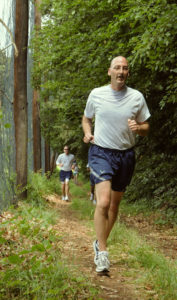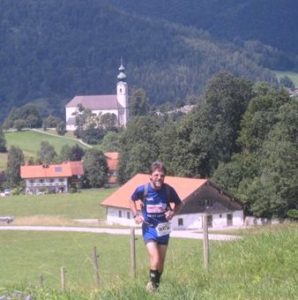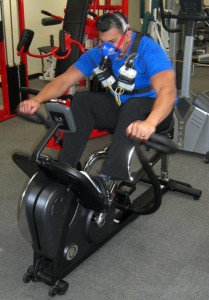How much aerobic fitness are you losing?
If you were the regular exerciser four to six days per week, are you losing cardio fitness with a modified routine? Is it mental anguish or physiological fact?
For the elite runner, they can still run and compare performance and feeling. High-level endurance athletes tend to be in total touch with their bodies and their state of fitness.

Hard-core, gym-based regular exercisers are just a bit behind however as their perceptions of fitness are based upon metrics like calories burned, speed on the step mill, etc. For the experienced-based gym exerciser those fitness thermometers are not there like the endurance athlete. Both of these groups perceive small changes as large chasms of fitness to re-bridge. How much is perception versus actual fitness loss?

The research concludes is that the higher the level of peak fitness, the more fitness that can be lost in different levels of decreases in training. If you just went to the gym three to five times per week, and performed moderate intensity energy system workouts, you might just maintain reasonably well in this time of home exercise. Remember, the higher the fitness level, the more potential for de-training.
There have been two general types of de-training studies. Total cessation from activity, like bed rest. That provides a projection of what happens when you just stop all together. The second form of studies are those where you taper down and reduce total training some amount or for a period of time. A number of the studies have viewed de-training as a reduction of training volume by 50%. The time frame has generally ranged from two weeks to three months.
There is enough information we can make some conclusions that help with adjusting both expectations and fitness routines during the Covid lifestyle modification period.

If you are a moderate exerciser and maintain a moderate routine, your fitness might only drop 5-10% from less activity. So, walking briskly twice per week, or some online classes that have an interval component two times per week, and you won’t lose much. Less volume means you should probably be more aware of intensity. And, as the research has determined, you can’t really substitute steps for sustained aerobic activity at a beneficial threshold. Steps are additive in terms of moderate health benefits, yet not contributory to fitness and higher levels of benefit.
For the more serious fitness enthusiast, it becomes a little more complicated. The first concept is that if you entered this period with peak fitness, that can only be maintained so long anyways, so it would have declined a bit. For endurance abilities, the first thing to decline is “threshold” or Anaerobic Threshold (AT). This is simply the point at which you transition from steady state to sprint metabolism. Most people who are in tune with their endurance abilities from significant experience know this point by feel.

Decreasing the volume and intensity with respect to this ability will result in running or cycling a bit slower at a steady state pace. People notice this more than their overall ability to jog for six miles. You can still do it, yet a bit slower.
A practical summation is reducing energy system training by 50% will only result in a 10% loss of energy system fitness. More AT than cardiovascular (VO2 max) in nature. The good news is two to three weeks of resuming activity will result in getting those levels back to previous. It simply feels more serious than the physiological reality. And, you can probably get away with up to two months of reduced activity before you get to another performance bump down.

The 64-calorie question is do different modes of energy exercise transfer to your dominant activity? No matter if you are a runner or a gym devotee’, you are likely cycling and walking more than you did previous. That does have a moderate to high transfer to your other activities whether they be running, stair climbing or elliptical. Not 100%, probably 85% if you keep the same volume and intensity patterns. The all-in-one classes are less likely to transfer because you are working on almost the total fitness spectrum, and likely only for 30 minutes.
When the stay at home clouds break, it will take approximately two to three weeks to adapt general energy system fitness to your specific patterns. The practical application is on aerobic/endurance days you will have to go a bit slower because AT is lower. It would probably be wise to spend one week in longer duration workouts before moving on to interval training. Just as insurance that you have that “aerobic base.” On interval days, you will likely need to increase the recovery time and decrease the recovery intensity in the short term.
References
Costill DL, Fink WJ, Hargreaves M, King DS, Thomas R, Fielding R. (1985) Metabolic characteristics of skeletal muscle during detraining from competitive swimming. Med Sci Sports Exerc;17(3):339–343.
Coyle EF, et al. (1986) Effects of Detraining on Cardiovascular Responses to Exercise: Role of Blood Volume. Journal of Applied Physiology;60(1):95–99.
Joo CH. (2016) The effects of short-term detraining on exercise performance in soccer players. J Exerc Rehabil;12(1):54–59. Published 2016 Feb 1. doi:10.12965/jer.160280
Kindermann W, Simon G, Keul J. (1979) The significance of the aerobic-anaerobic transition for the determination of work load intensities during endurance training. Eur J Appl Physiol;42: 25–34
Knuiman P, Hopman MT, Mensink M. (2015) Glycogen availability and skeletal muscle adaptations with endurance and resistance exercise. Nutr Metab (Lond);12:59.
Lee I, Shiroma EJ, Kamada M, Bassett DR, Matthews CE, Buring JE. (2019) Association of Step Volume and Intensity With All-Cause Mortality in Older Women. JAMA Intern Med;179(8):1105–1112.
Moore RL, Thacker EM, Kelley GA, Musch TI, Sinoway LI, Foster VL, Dickinson AL. (1987) Effect of training/detraining on submaximal exercise responses in humans. J Appl Physiol;63:1719-24.
Mujika I, Padilla S. (2000) Detraining: Loss of Training-Induced Physiological and Performance Adaptations. Part I. Sports Medicine;30(2):79–87.
Mujika I, Padilla S. (2000) Detraining: Loss of Training-Induced Physiological and Performance Adaptations. Part II. Sports Medicine;30(3):145–154.
Neufer PD. (1989) The Effect of Detraining and Reduced Training on the Physiological Adaptations to Aerobic Exercise Training. Sports Medicine;8(5):302–321.
Pierce EF, Weltman A, Seip RL., Snead D. (1990) Effects of training specificity on the lactate threshold and VO2 peak. International Journal of Sports Medicine;11;267-272.
Stangier C, Abel T, Mierau J, Hollmann W, Strüder HK. (2016) Effects of Cycling Versus Running Training on Sprint and Endurance Capacity in Inline Speed Skating. J Sports Sci Med;15(1):41–49.
Tyler CM, Golland LC, Evans DL, Hodgson DR, Rose RJ. (1996) Changes in maximum oxygen uptake during prolonged training, overtraining, and detraining in horses. Journal of Applied Physiology;81:(5):2244-2249.
Withers RT, Sherman WM, Miller JM. et al. (1981) Specificity of the anaerobic threshold in endurance trained cyclists and runners. Europ. J. Appl. Physiol;47:93–104.

